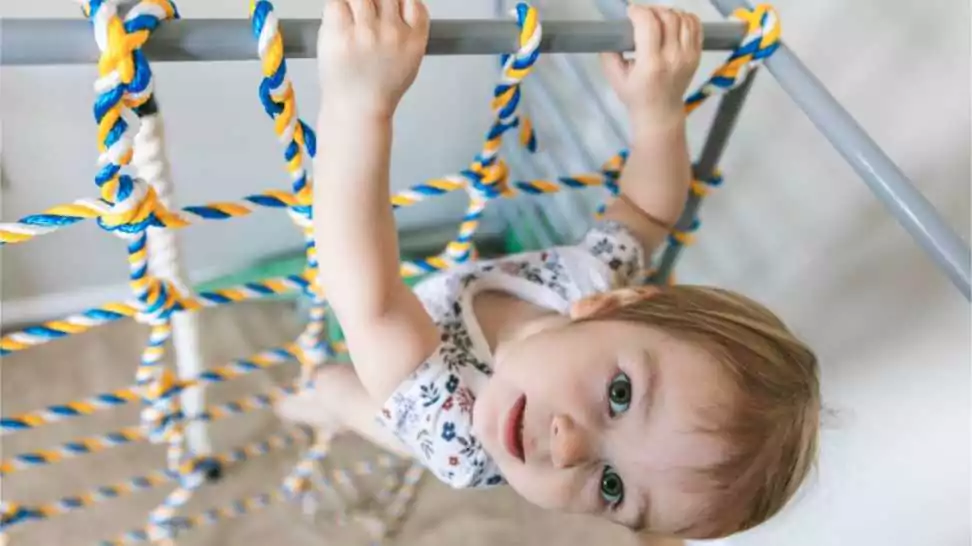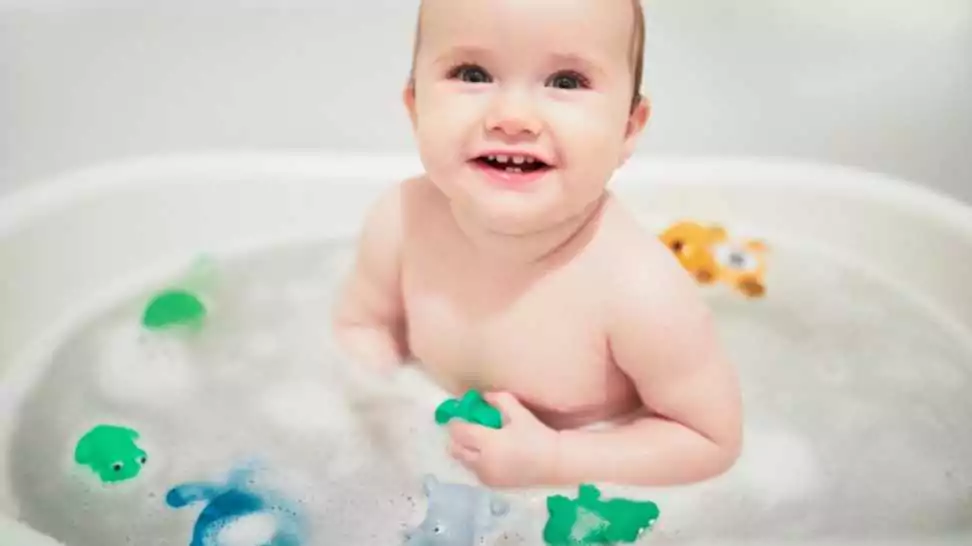When Can Baby Sit In Bath Without Seat?

As parents, one of the most joyous yet challenging experiences is witnessing the rapid development of our little ones. Among these significant milestones is the transition from lying down to sitting up, a phase that brings about a mix of excitement and caution. This developmental leap is not just about physical growth; it’s a testament to your baby’s advancing motor skills, muscle strength, and coordination. Understanding these milestones is crucial, particularly regarding activities like bath time, which intertwine care with safety.
Bath time is more than just a routine; it’s a delightful ritual that fosters bonding, sensory exploration, and, of course, cleanliness. However, as your baby grows, how you manage bath time needs to adapt. One significant change is the transition from using a bath seat to allowing your baby to sit independently in the bathtub. This shift is not merely a matter of convenience but a vital step that ensures the safety and comfort of your child.
In this blog, we will explore the right time and conditions for this transition. It’s essential to recognize that each child is unique, and their readiness to sit unassisted in a bath varies. We’ll explore the developmental signs that indicate when can baby sit in bath without seat, along with safety tips to make this transition smooth and secure. After all, ensuring a safe and enjoyable bath time is paramount in nurturing your baby’s love for this daily ritual.
1 Understanding Baby's Developmental Stages
Overview of Typical Age Range for Babies Sitting Up Unaided
As parents eagerly await each developmental milestone, one of the most significant is when a baby begins to sit up independently. This milestone is typically reached between the ages of 4 to 7 months. However, it’s important to remember that every child is unique, and some may sit up a bit earlier or later than this timeframe. It’s not just about reaching an age; it’s about physical and developmental readiness.
Physical Signs of Readiness

To safely transition from a bath seat to sitting unaided in the tub, parents should observe certain physical signs of readiness in their baby. These signs include:
- Strong Neck and Back Muscles: Your baby should be able to hold their head up steadily without support. This ability indicates that the neck muscles are strong enough to handle the demands of sitting upright.
- Ability to Hold Head Up: Along with strong neck muscles, the baby should consistently hold their head up when in a seated position. This skill is crucial for sitting independently and showing control over their upper body.
- Balance While Seated: Initially, babies might use their hands to support themselves (known as “tripod sitting”), but gradually, they should be able to sit without using their hands for balance. This advancement suggests they have developed enough core strength to maintain an upright position.
The Role of Gross Motor Skills in Sitting Up

Gross motor skills play a vital role in a baby’s ability to sit up. These skills involve the larger muscles in the body and are crucial for major movements such as rolling over, crawling, and sitting. The development of gross motor skills is a cumulative process. As babies grow, they gain control and strength in their muscles, starting from the head and moving down to the legs. This progression is why head control is typically mastered before sitting up.
Sitting up independently is a complex coordination of various muscle groups, including those in the back, neck, and core. As these muscles strengthen and work together, your baby gradually gains the stability and balance needed for sitting up without support.
2 Safety Considerations in the Bath
The Importance of Never Leaving a Baby Unattended in the Bath
One of the cardinal rules of infant bath time is to never leave a baby unattended in the bath, not even for a moment. The risk of drowning is real and can occur in just a few inches of water and a matter of seconds. A responsible adult must be always present, keeping a watchful eye and a supportive hand within reach of the baby during bath time.

Tips for Making the Bath Environment Safe
Creating a safe bath environment is essential for transitioning your baby from a bath seat to sitting independently. Here are some tips to enhance safety:
- Use Non-Slip Mats: Placing non-slip mats inside and outside the tub can significantly reduce the risk of slips and falls. These mats provide a stable surface for your baby to sit on and also provide secure footing for you when handling your baby.
- Monitor Water Temperature: The ideal bath water temperature for babies is around 100°F (37.8°C). It’s crucial to use a bath thermometer or test the water with your wrist or elbow to ensure it’s warm, not hot, to prevent scalding.
- Avoid Hazards: Keep the bath area free from potential hazards. This means removing any electrical appliances from the vicinity, ensuring that bath products are out of reach when not in use, and avoiding toys that are small enough to pose a choking hazard.
Recognising and Avoiding Risks of Slips and Falls
- As babies learn to sit independently in the bath, they are exploring and developing their motor skills, which can sometimes lead to slips and falls. To minimise these risks:
- Ensure constant supervision. Be ready to support your baby if they seem unstable or are making sudden movements.
- Avoid filling the tub with too much water. A few inches are sufficient for a baby to enjoy bath time safely.
- When lifting your baby in and out of the bath, do so slowly and securely. Wet babies can be slippery, so use both hands and keep a firm grip.
3 Transitioning from Bath Seat to Sitting Independently
Ideal Age Range for Most Babies to Make This Transition
The transition from using a bath seat to sitting independently in the bath is a significant milestone and typically occurs around the age of 6 to 8 months. However, it’s crucial to base this transition on your baby’s individual development rather than strictly adhering to a specific age.
Look for the signs of readiness discussed above, such as the ability to sit without support, strong neck and back muscles, and good balance.
Gradual Steps to Help Baby Adjust
Transitioning to sitting independently in the bath should be a gradual process. Here’s how you can help your baby adjust:
Start with Shorter Periods Without the Seat: Initially, allow your baby to sit without the bath seat for short periods during bath time. You can gradually increase this duration as your baby becomes more comfortable and stable.
Constant Supervision: Throughout this transition, it’s imperative to provide constant supervision. Stay within arm’s reach, ready to assist or steady your baby if it wobbles or seems uneasy.
Create a Supportive Environment: Surround your baby with a few toys to make the sitting experience enjoyable and engaging. This approach helps in developing their balance and coordination in a playful, stress-free environment.
Encouraging Baby’s Independence While Ensuring Safety

As your baby becomes more confident in their ability to sit independently, it’s important to encourage this newfound independence while still ensuring safety:
Offer Encouragement and Praise: Celebrate your baby’s efforts and successes in sitting up independently. Positive reinforcement can boost their confidence and enjoyment of bath time.
Maintain a Safe Water Level: Keep the water level low (no higher than your baby’s waist when seated) to reduce the risk of accidents.
Introduce Bath Toys Carefully: Provide bath toys that are large enough to be safe but engaging enough to keep your baby seated and entertained. These toys can also help improve their motor skills and coordination.
Stay Attentive: Even as your baby becomes more independent, never compromise on supervision. It’s crucial to remain vigilant to ensure their safety at all times.
4 Supporting Your Baby's Independence
Supporting Your Baby Physically and Emotionally During Bath Time
As your baby embarks on the journey of sitting independently in the bath, your support plays a crucial role in their physical and emotional development. Here’s how you can provide this support:
- Physical Support: In the initial stages, you might need to physically support your baby by holding them lightly around the waist or shoulders as they sit. Gradually reduce the level of support as they gain confidence and stability.
- Emotional Support: Offer plenty of smiles, verbal encouragement, and eye contact. Your positive reactions and gentle tone of voice can significantly boost their confidence and make bath time an enjoyable experience.
5 Activities and Toys to Encourage Sitting Up in the Bath

Interactive activities and toys can greatly aid in encouraging your baby to sit up independently. Consider the following:
- Floating Toys: Use toys that float and encourage your baby to reach out and grab them. This activity not only keeps them entertained but also improves their balance and coordination.
- Pouring and Filling Activities: Introduce toys like cups and containers for pouring and filling. These activities are not only fun but also help in developing fine motor skills and hand-eye coordination.
- Colourful and Textured Toys: Brightly coloured and various textured toys can stimulate your baby’s sensory development and keep them engaged while sitting.
Balancing Supervision with Allowing Exploration and Play
While supervision is non-negotiable, it’s important to strike a balance that allows your baby to explore and play. Here’s how:
- Stay Close, But Give Space: Stay within arm’s reach, but avoid intervening too much. This approach gives your baby the space to explore their abilities and surroundings.
- Safe Environment for Exploration: Ensure the bath area is safe for exploration. Avoid sharp edges, and ensure all bath products are baby-safe and non-toxic.
Let Them Lead: Follow your baby’s cues. If they seem interested in a particular toy or activity, let them explore it. This autonomy is crucial for their cognitive and emotional development. - Use Bath Time for Bonding: Engage in interactive play, sing songs, or tell simple stories. This not only supports your baby’s emotional development but also strengthens your bond with them.
6 When to Consult a Paediatrician?
Signs That May Indicate a Need for Professional Advice
While every child develops at their own pace, certain signs may indicate the need to consult a paediatrician for advice and guidance. These include:
- Delays in Sitting Up: If your baby hasn’t started sitting independently or showing signs of sitting up by the age of 9 months, it’s a good idea to discuss this with your paediatrician. Delays in reaching this milestone could be a sign of developmental issues.
- Discomfort in Sitting Positions: Notice if your baby seems uncomfortable or distressed when attempting to sit. This could include persistent crying, reluctance to sit, or appearing to struggle with maintaining balance.
- Lack of Coordination or Muscle Tone: Weak muscle tone or lack of coordination can be a concern. If your baby seems floppy or overly stiff, a professional evaluation is recommended.
- Other Developmental Concerns: If you observe any other developmental concerns, such as issues with vision, hearing, or interactions, it’s essential to consult with a healthcare professional.

The Importance of Regular Pediatric Check-Ups and Developmental Screenings
Regular paediatric check-ups and developmental screenings are vital in monitoring your baby’s growth and development. These appointments are opportunities for your paediatrician to identify any developmental delays or concerns early on. They also provide a platform for you to discuss any worries or questions you might have about your child’s development.
During these check-ups, your paediatrician will:
- Assess your baby’s growth in terms of height, weight, and head circumference.
- Evaluate developmental milestones, including sitting, crawling, and early speech.
- Discuss feeding, sleep habits, and overall health.
- Provide vaccinations as needed to protect against various diseases.
7 Tips and Tricks from Parents
Real-Life Advice and Experiences from Other Parents
Parenting is a journey best navigated with a community’s wisdom. Here, we share some invaluable tips and tricks from experienced parents that can make the transition to independent sitting in the bath smoother and more enjoyable:
- Start with a Bath Buddy: Some parents have found that a small, waterproof stuffed toy can be a great companion for their baby during bath time. It gives the baby something to focus on and interact with, making them feel more secure as they adjust to sitting independently.
- Sing-Along Sessions: Bath time can be an excellent opportunity for sing-alongs. Not only does this keep your baby entertained, but it also helps them associate bath time with fun and relaxation.
- Consistent Routine: Establishing a consistent bath time routine helps your baby know what to expect, making them feel more comfortable and secure. This could include a specific sequence of activities like playing with a particular toy, then washing, followed by a special song or game.
Creative Ideas and Solutions for Bath Time Challenges
Sometimes, bath time can present unique challenges. Here are some creative ideas from parents who have been there:
- DIY Non-Slip Mats: For an extra layer of safety, some parents use cut-out yoga mats at the bottom of the tub to prevent slipping.
- Temperature Games: Make checking water temperature fun by using a thermometer that changes colour or has playful designs. It turns a safety step into an engaging activity.
- Story Time in the Tub: Engage your baby with waterproof books. Reading in the bath can be a delightful experience and a great way to develop a love for stories.
Emphasising the Community Aspect of Parenting and Shared Experiences
Parenting, while challenging, becomes easier and more enjoyable when shared with others. Connecting with a community of parents allows for the exchange of tips, advice, and support. Whether it’s through online forums, local parenting groups, or casual meet-ups, sharing experiences can provide new perspectives, creative solutions, and a sense of camaraderie.
Parenting Groups and Forums: These platforms can be a treasure trove of advice and shared experiences. They provide a space to ask questions, share successes, and even vent about the challenges of parenthood.
Playdates and Gatherings: Interacting with other parents and babies in person can be incredibly beneficial. It allows for the exchange of tips in a more personal and relatable setting.
8 Wrapping Up
The journey of parenting is filled with these beautiful milestones, each bringing its challenges and joys. As you navigate through them, remember that you’re not alone. The parenting community is a fantastic resource for support and advice. Embrace this journey with an open heart, patience, and a sense of humour. Watching your baby grow and gain new skills is one of life’s most rewarding experiences.
In conclusion, as you support your baby through this transition, cherish these moments. The days of helping your little one sit in a bath will pass quickly, and before you know it, you’ll be onto the next exciting milestone.
Community Q&A
About This Article
This article has been viewed 107 times.



